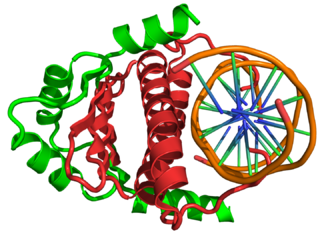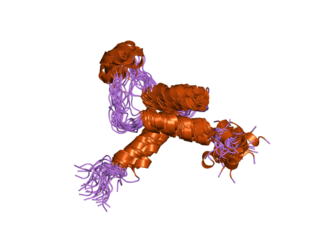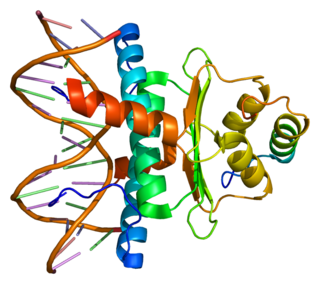Myocyte-specific enhancer factor 2D is a protein that in humans is encoded by the MEF2D gene. [5] [6]
Myocyte-specific enhancer factor 2D is a protein that in humans is encoded by the MEF2D gene. [5] [6]
MEF2D has been shown to interact with:

MyoD, also known as myoblast determination protein 1, is a protein in animals that plays a major role in regulating muscle differentiation. MyoD, which was discovered in the laboratory of Harold M. Weintraub, belongs to a family of proteins known as myogenic regulatory factors (MRFs). These bHLH transcription factors act sequentially in myogenic differentiation. Vertebrate MRF family members include MyoD1, Myf5, myogenin, and MRF4 (Myf6). In non-vertebrate animals, a single MyoD protein is typically found.

Histone acetyltransferase p300 also known as p300 HAT or E1A-associated protein p300 also known as EP300 or p300 is an enzyme that, in humans, is encoded by the EP300 gene. It functions as histone acetyltransferase that regulates transcription of genes via chromatin remodeling by allowing histone proteins to wrap DNA less tightly. This enzyme plays an essential role in regulating cell growth and division, prompting cells to mature and assume specialized functions (differentiate), and preventing the growth of cancerous tumors. The p300 protein appears to be critical for normal development before and after birth.

Transcription factor Sp1, also known as specificity protein 1* is a protein that in humans is encoded by the SP1 gene.

In the field of molecular biology, myocyte enhancer factor-2 (Mef2) proteins are a family of transcription factors which through control of gene expression are important regulators of cellular differentiation and consequently play a critical role in embryonic development. In adult organisms, Mef2 proteins mediate the stress response in some tissues. Mef2 proteins contain both MADS-box and Mef2 DNA-binding domains.

Histone deacetylase 1 (HDAC1) is an enzyme that in humans is encoded by the HDAC1 gene.

TEAD2, together with TEAD1, defines a novel family of transcription factors, the TEAD family, highly conserved through evolution. TEAD proteins were notably found in Drosophila (Scalloped), C. elegans, S. cerevisiae and A. nidulans. TEAD2 has been less studied than TEAD1 but a few studies revealed its role during development.

Paired amphipathic helix protein Sin3a is a protein that in humans is encoded by the SIN3A gene.

Histone deacetylase 4, also known as HDAC4, is a protein that in humans is encoded by the HDAC4 gene.

Mitogen-activated protein kinase 7 also known as MAP kinase 7 is an enzyme that in humans is encoded by the MAPK7 gene.

Myocyte-specific enhancer factor 2C also known as MADS box transcription enhancer factor 2, polypeptide C is a protein that in humans is encoded by the MEF2C gene. MEF2C is a transcription factor in the Mef2 family.

C-terminal-binding protein 1 also known as CtBP1 is a protein that in humans is encoded by the CTBP1 gene. CtBP1 is one of two CtBP proteins, the other protein being CtBP2.

YY1 is a transcriptional repressor protein in humans that is encoded by the YY1 gene.

Myocyte-specific enhancer factor 2A is a protein that in humans is encoded by the MEF2A gene. MEF2A is a transcription factor in the Mef2 family. In humans it is located on chromosome 15q26. Certain mutations in MEF2A cause an autosomal dominant form of coronary artery disease and myocardial infarction.

General transcription factor II-I is a protein that in humans is encoded by the GTF2I gene.

Histone deacetylase 5 is an enzyme that in humans is encoded by the HDAC5 gene.

Histone deacetylase 9 is an enzyme that in humans is encoded by the HDAC9 gene.

Calcium/calmodulin-dependent protein kinase type 1 is an enzyme that in humans is encoded by the CAMK1 gene.

Interferon-related developmental regulator 1 is a protein that in humans is encoded by the IFRD1 gene. The gene is expressed mostly in neutrophils, skeletal and cardiac muscle, the brain, and the pancreas. The rat and the mouse homolog genes of interferon-related developmental regulator 1 gene are also known with the name PC4 and Tis21, respectively. IFRD1 is member of a gene family that comprises a second gene, IFRD2, also known as SKmc15.

Calcineurin-binding protein cabin-1 is a protein that in humans is encoded by the CABIN1 gene.

Myocyte enhancer binding factor 2B (MEF2B) is a transcription factor part of the MEF2 gene family including MEF2A, MEF2C, and MEF2D. However, MEF2B is distant from the other three branches of MEF2 genes as it lacks the protein-coding Holliday junction recognition protein C-terminal (HJURP_C) region in vertebrates.